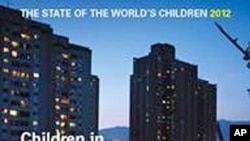The United Nations Children's Fund warns hundreds of millions of children who live in cities and towns are excluded from vital services, including health, education, clean water and sanitation. In this year’s State of the World's Children report, UNICEF describes the grim reality of children growing up in poverty in city slums, which offer few of the benefits available to children of a wealthier class.
Cities are great places for people who can afford to go to the doctor, get an education and take advantage of the many recreational activities available. But, cities are not such great places for poor children forced to live in slums and shantytowns.
The U.N. Children’s Fund says these children are among the most disadvantaged and vulnerable in the world. It says they live amid violence and exploitation. They are deprived of the most basic services and denied a chance to thrive.
UNICEF’s "State of the World’s Children Report" finds overcrowding and unsanitary conditions in these slums rapidly spread diseases such as pneumonia and diarrhea, two of the biggest killers of children under five in the world.
The report notes one urban resident in three lives in a slum. This rises to six in 10 in Africa. It says many children in slums live close to vital services, such as schools and clinics. The problem, it says, is they are excluded from these services because of poverty and discrimination.
UNICEF spokeswoman, Marixie Mercado, says these problems begin at birth.
“One-third of children in urban areas are not registered at birth," said Mercado. "That proportion rises almost half in Africa, makes them much more vulnerable to exploitation throughout their lives. Slum dwellers, for example, living without secure land tenure always live with the permanent risk of being evicted. This gives them absolutely no incentive to improve their households or their communities and it contributes to a huge sense of insecurity for children and their families.”
And, UNICEF warns the situation is likely to get worse unless governments put children at the heart of urban planning and improve services for all. Today, more than half of all people, including more than one billion children, live in urban settings. By 2050, the United Nations predicts, 70 percent of the world population will live in cities.
Mercado says the increase in the number of slum-dwellers will only add to the deplorable conditions under which so many children are forced to live.
“In Kenya, for example, a study in 2009 showed that stunting rates among children in the slums of Nairobi were almost three times higher than in urban areas in general," she said. "In Bangladesh, mortality rates among children in slums was higher than both the rural and the urban rates, generally.”
But, the report cites other studies where cities have implemented programs, which are benefiting the poor. Mexico has an initiative which provides cash to the poorest families to send their children to school and pay for health care. This operates in both rural and urban areas and is now being followed by other countries.
UNICEF says steps such as the abolition of medical and school fees will improve children’s health and allow many more children to get an education. The agency says vital services often are available to the poor, but they are unaware of this. It says it is important that slum-dwellers be informed of their rights.
UNICEF: Hundreds of Millions of City Children Lack Vital Services
- By Lisa Schlein








